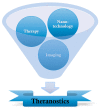Novel Tumor-Targeting Nanoparticles for Cancer Treatment-A Review
- PMID: 35563645
- PMCID: PMC9101878
- DOI: 10.3390/ijms23095253
Novel Tumor-Targeting Nanoparticles for Cancer Treatment-A Review
Abstract
Being one of the leading causes of death and disability worldwide, cancer represents an ongoing interdisciplinary challenge for the scientific community. As currently used treatments may face limitations in terms of both efficiency and adverse effects, continuous research has been directed towards overcoming existing challenges and finding safer specific alternatives. In particular, increasing interest has been gathered around integrating nanotechnology in cancer management and subsequentially developing various tumor-targeting nanoparticles for cancer applications. In this respect, the present paper briefly describes the most used cancer treatments in clinical practice to set a reference framework for recent research findings, further focusing on the novel developments in the field. More specifically, this review elaborates on the top recent studies concerning various nanomaterials (i.e., carbon-based, metal-based, liposomes, cubosomes, lipid-based, polymer-based, micelles, virus-based, exosomes, and cell membrane-coated nanomaterials) that show promising potential in different cancer applications.
Keywords: cancer management; cancer treatment; combined cancer therapies; controlled drug delivery; nanomedicines; novel nanocarriers; theranostics; tumor-targeting nanoparticles.
Conflict of interest statement
The authors declare no conflict of interest.
Figures















References
-
- Kaur C., Garg U. Artificial intelligence techniques for cancer detection in medical image processing: A review. Mater. Today Proc. 2021. in press . - DOI
-
- Garg P. Selective Preference of Antibody Mimetics over Antibody, as Binding Molecules, for Diagnostic and Therapeutic Applications in Cancer Therapy. Biointerface Res. Appl. Chem. 2021;11:10765–10775. doi: 10.33263/briac113.1076510775. - DOI
-
- Arifin M.Z., Parikesit A.A., Agustriawan D. Molecular simulation oF MDM2 and E6AP proteins as P53 regulator in cervical cancer. Biointerface Res. Appl. Chem. 2020;10:5875–5879. doi: 10.33263/BRIAC104.875879. - DOI
Publication types
MeSH terms
Substances
LinkOut - more resources
Full Text Sources
Medical
Research Materials

